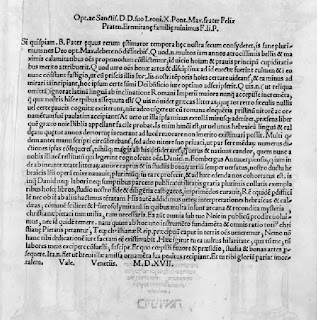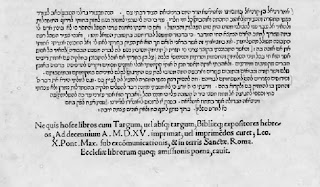Jordan S. Penkower – Some Notes Regarding the First & Second Rabbinic Bibles
by Jordan S. Penkower
Dr. Jordan S. Penkower is an associate professor in the Bible Department at Bar Ilan University, and has written extensively on the development of the printed Hebrew Bible.
This is his first contribution to the Seforim blog.
In response to the post at the Seforim blog regarding the Pinner Talmud, a correction is in order regarding the first two Rabbinic Bibles (both now available online – see below). The post states
In fact, this would not be the first time a dedication didn’t work out that well. The first Rabbinic bible published in 1522, was not a success. Instead, it would be the second Rabbinic bible that became the template for the Mikrot Gedolot Chumash. While both were done by the same publisher and soon after one another. The main difference was the first contained a dedication to the Pope, while the second did not. Perhaps, the same happened here, and Pinner was a victim of poor judgment in securing his approbations, both in the one’s that appeared and the ones that did not.
(1)The first Rabbinic Bible was published by Bomberg in Venice and completed in 1517. The editor was the convert Felix Pratensis. This edition appeared in two versions: one with a dedication to the Pope in Latin (on the verso of the title page), and at the end of Chronicles a short decree by the Pope (in Latin) that this edition had exclusive rights for 10 years. The second – aimed at the Jews – without the Latin material.
(2) The second Rabbinic Bible was published by Bomberg in Venice, and completed in 1525. The editor of this edition was Jacob ben Hayyim Ibn Adoniyahu (who converted to Christianity sometime after 1527).
These two editions differ in a number of ways (the lack of the Latin material is not really to be considered, because such a Latin-free edition had already appeared in 1517 – see above).
Here, I will note the following differences between the two editions: (a) more commentaries in the second edition; (b) the printing of the whole apparatus of the Masorah Parva, the Masorah Magna, and the Masorah Finalis – for the first time in the second (1525) edition; (c) the bible text in the second edition was re-edited anew based on manuscripts and Masorah. As a result, one finds variants in text, vocalization and accentuation between these two editions.
Further details on the differences between these editions can be found in my Jacob ben Hayyim and the Rise of the Rabbinic Bible (Ph.D. dissertation, Hebrew University, 1982; Hebrew); see further my articles in: J.H. Hayes, ed., Dictionary of Biblical Interpretation (Abingdon Press, Nashville 1999), vol. 1: “Bomberg, Daniel,” “Jacob Ben Hayyim Ibn Adoniyahu,” and vol. 2: “Rabbinic Bible.”
Dedication Page to the Pope from the 1517 ed.

